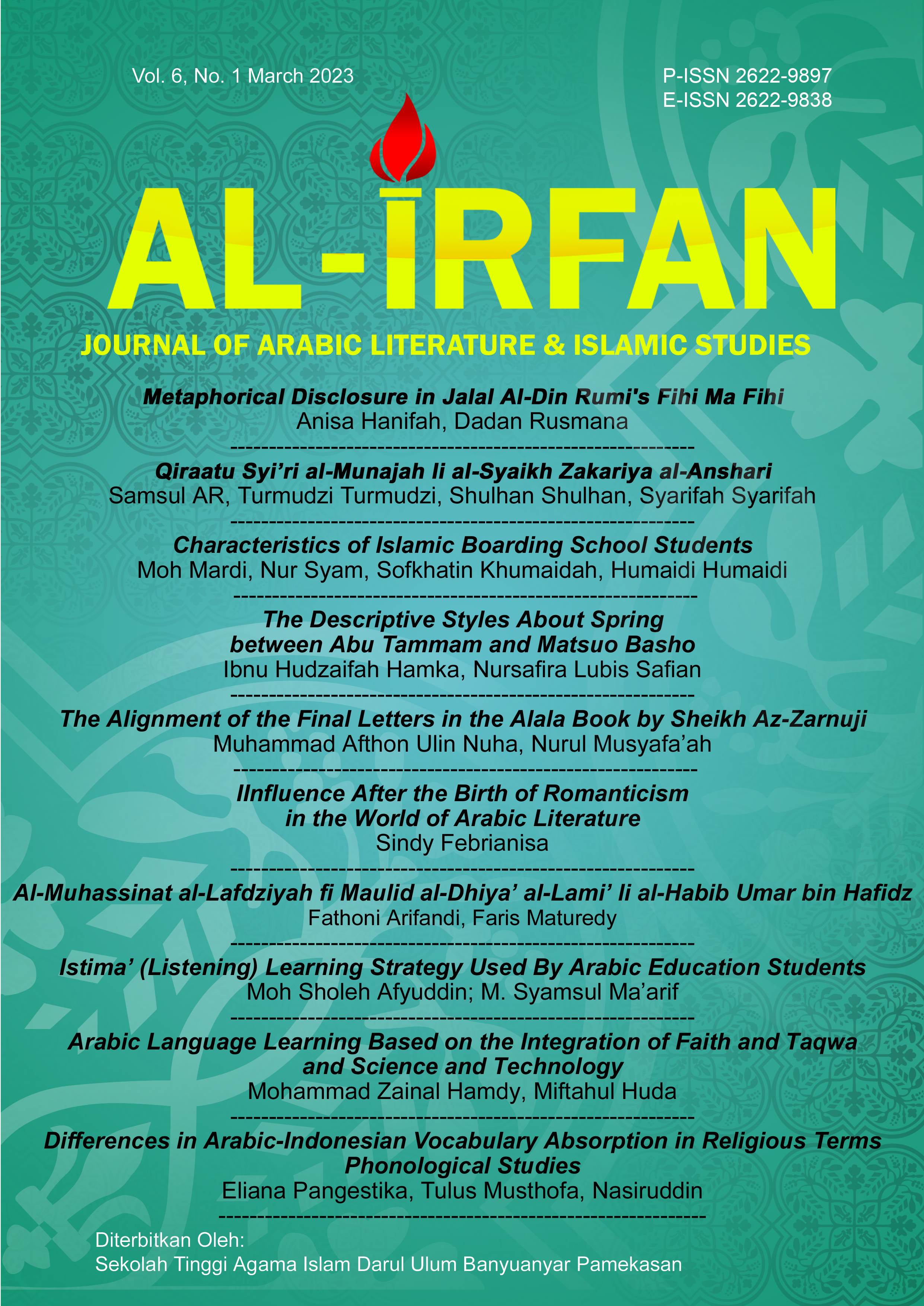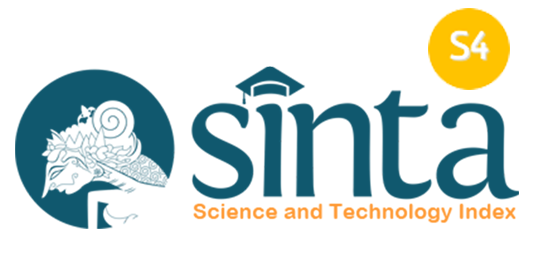The Descriptive Styles About Spring between Abu Tammam and Matsuo Basho
A Comparative Study
DOI:
https://doi.org/10.58223/alirfan.v6i1.5782Keywords:
Spring, Abu Tammam, Matsuo Basho, Arabic Poet, HaikuAbstract
Abu Tammam is considered a great Arab poet of his time. Abu Tammam created various poems from different topics such as spinning, praise, satire, and some of his poems include nature poetry about spring. On the other hand, Matsuo Basho was one of the most famous Japanese poets, but the greatest in writing haiku, and of most of his poetry about nature and its phenomena. Based on this, the researchers view that they should to be studied and analyzed the issue, and then compare the two poems of both poets. The study aims to show their creativity in formulating the two poems, and to reveal the aspects of agreements and disagreement between their vision, using the descriptive analytical method before resorting to the American School approach in comparative study, where the study attempts to highlight on the similiarites and differences between the two studied poems. The study found that both poems are full of descriptive styles by the presence of plants and rain. However, the use of descriptive styles in the two poems differs from one poet to another. Where Matsuo Basho deals in his poetry with styles that refer to the signs of nature from the names of animals such as birdds, sparrows, butterflies, mice and bats, and these nouns were not found in Abu Tamam’s poem. While the names of the cosmic such as the sun, the moon and the earth combined more for description or similes and metaphor in Abu Tamam poem. These differences are due to the difference in culture, language, and geographical condition between the two studied literatures: Arabs and Japan.References
المراجع العربية
ابن أوس، Øبيب. (ت231Ù‡). ديوان أبي تمام الطائي (د.Ø·). Ù…ØÙŠ الدين الخياط (Ù…Ùسر الالÙاظ ووق٠على طبعه). د.Ù…: Ù…Øمد جمال
ابن منظور، جمال الدين. (1414هـ). لسان العرب (ط3). بيروت: دار صادر
بدر، عادل. "الإيقاع وعناصر الشعرية العربية، اختلا٠الشكل الموسيقي المتØقق" صØÙŠÙØ© المثق٠(19 Ùبراير 2018). < http://www.almothaqaf.com/b2/925359>
الجارم، علي؛ أمين، مصطÙÙ‰. (د.ت) البلاغة الواضØØ© (د.Ø·). (د.Ù…): دار المعارÙ.
جرار، الاء. من هو أبو تمام. موضوع: أكبر موقع عربي بالعالم. < https://mawdoo3.com/%D9%85%D9%86_%D9%87%D9%88_%D8%A3%D8%A8%D9%88_%D8%AA%D9%85%D8%A7%D9%85#.D8.A7.D9.84.D9.85.D8.B1.D8.A7.D8.AC.D8.B9> آخر تعديل 19 يناير 2020.
الجماس، ضياء الدين. "الÙرق بين الوزن والإيقاع" منتدى العروض رقميا آخر تعديل (أكتوبر 2013) < http://www.arood.com/vb/showthread.php?t=7513>
جمال الدين، مصطÙÙ‰. (1390Ù‡/1970Ù…). الإيقاع ÙÙŠ الشعر العربي من البيت إلى التÙعيلة (د.Ø·). د.Ù…: مطبعة النعمان.
الØجية، ÙالØ. "الأساليب الشعرية" مركز النور < http://www.alnoor.se/article.asp?id=206602> آخر تعديل 1 يوليو 2013.
الرزقاني، Ù…Øمد عبد العظيم. (1362Ù‡/1943Ù…). مناهل العرÙان ÙÙŠ علوم القرآن (Ø·3). د.Ù…: مطبعة عيسى البابي الØلبي وشكاه.
السكاكي، أبو يعقوب يوس٠ابن أبي بكر بن علي. (1407Ù‡/1987Ù…). Ù…ÙØªØ§Ø Ø§Ù„Ø¹Ù„ÙˆÙ… (Ø·2). نعيم زرزور (تØقيق). بيروت: دار الكتب العلمية.
الصولي، أبي بكر Ù…Øمد بن ÙŠØيى. (1356هـ/1937Ù…). أخبار أبي تمام (Ø·1). القاهرة: مطبعة التألي٠والترجمة والنشر.
علي، عبد الصاØب مهدي. "ÙÙŠ Ù…Ùهوم الشعر ولغته: خصائص النص الشعري" مجلة جامعة الشارقة تصدر عن جامعة الشارقة، المجلد 8ØŒ العدد 3 سنة 1432Ù‡/2011Ù…ØŒ ص237-257.
عيبات، لارا. "عناصر الشعر" موضوع: أكبر موقع عربي < https://mawdoo3.com/%D8%B9%D9%86%D8%A7%D8%B5%D8%B1_%D8%A7%D9%84%D8%B4%D8%B9%D8%B1> آخر تعديل 29 أكتوبر 2017.
غنيم، Ù…Øمد أبو الÙØªÙˆØ ØºÙ†ÙŠÙ…. "تعري٠الشعر ÙˆÙائدته ÙˆÙضله وعناصره" ديوان العرب < https://www.diwanalarab.com/%D8%AA%D8%B9%D8%B1%D9%8A%D9%81-%D8%A7%D9%84%D8%B4%D8%B9%D8%B1> آخر تعديل 14 مايو 2009.
Ù…Øمد Ø£Øمد قاسم، Ù…ØÙŠ الدين ديب. (2003). علوم البلاغة: البديع والبيان والمعاني (د.Ø·). طرابلس: المؤسسة الØديثة للكتاب.
مصطÙى، Ù…Øمود. (1417Ù‡/1996Ù…). أهدى السبيل إلى علمي الخليل: العروض والقاÙية (Ø·1). بيروت: عالم الكتب.
مهدي، Øجازي Øسين. (2007). أبو تمام Øبيب بن أوس الطائي: دراسة نقدية ÙÙŠ تجربة الشعرية. رسالة الدكتورة غير منشورة، خرطوم: جامعة الخرطوم.
نوÙÙ„ØŒ سيد. (1945). شعر الطبيعة ÙÙŠ الادب العربي (د.Ø·). القاهرة: مطبعة مصر شكرة مساهة مصرية.
الهاشمي، السيد Ø£Øمد. (1999). جوهر البلاغة (د.Ø·). يوس٠المصيلي (تØقيق). بيروت: المكتبة العصرية.
الشايب، Ø£Øمد. (2003Ù…). الأسلوب (Ø·12). د.Ù…: مكتبة النهضة المصرية.
المراجع الأجنبية.
Asoo, Isoji. (1983). Nihon Bungakushi (Sejarah Kesustraan Jepang) (Ed.1). Departement of East Asia – Japan Section (Translator). Depok: UI Press.
Tasia, Anindya. “Analisis Kesalahan Siswa Dalam Penulisan Hiragana dan Katakana Di SMA N 15 Semarangâ€. (Undergraduate Thesis in Teaching of Japanese Language, Faculty of Language and Art, State University of Semarang, 2015).
Basho, Matsuo. (2004). Basho’s Haiku: Selected Poems by Matsuo Basho. B. David (Translator). New York: State University of New York Press.
Apriyani, Cindy. “Klasifikasi Kigo Pada Haiku Karya Seishi Yamaguchi Menggunakan Teori Semiotika Peirceâ€. (Undergraduate Thesis in Japanese Literature, Faculty of Literature, Darma Persada University, Jakarta, 2018).
Imanuella, Susia Kartika. “Makna Puitis Bunga Sakura Dalam Haiku Matsuo Basho dan Taigo Ryokan. (Undergraduate Thesis in Japanese Literature, Faculty of Culture, Departement of Japanese Literature, University of Hasanudin, Makassar, 2013).
Morita, Yasuko; Rismiyanti, Dila. (2017). Keunikan Sastra Jepang. Jakarta: Kesaint Blanc Publisher.
Setyowati, Dian; Poerbowati, Endang; D, Jupriono. “Kigo Pada Haiku Kobayashi Issa Dalam Perspektif Semiotika C.S. Pierceâ€. Parafrase, Vol.10, No.1, Februari 2010, p8-15.
Downloads
Published
How to Cite
Issue
Section
License
Copyright (c) 2023 Ibnu Hudzaifah Hamka, Nursafira Lubis Safian

This work is licensed under a Creative Commons Attribution 4.0 International License.
Lisensi :
Al-Irfan: Journal of Arabic Literature and Islamic Studies is published under conditions Creative Commons Attribution 4.0 International License / CC BY 4.0 This license permits anyone to copy and redistribute this material in any form or format, modify, modify, and make derivative works of this material for any purpose, including commercial purposes, so long as they credit the author for the original work.











